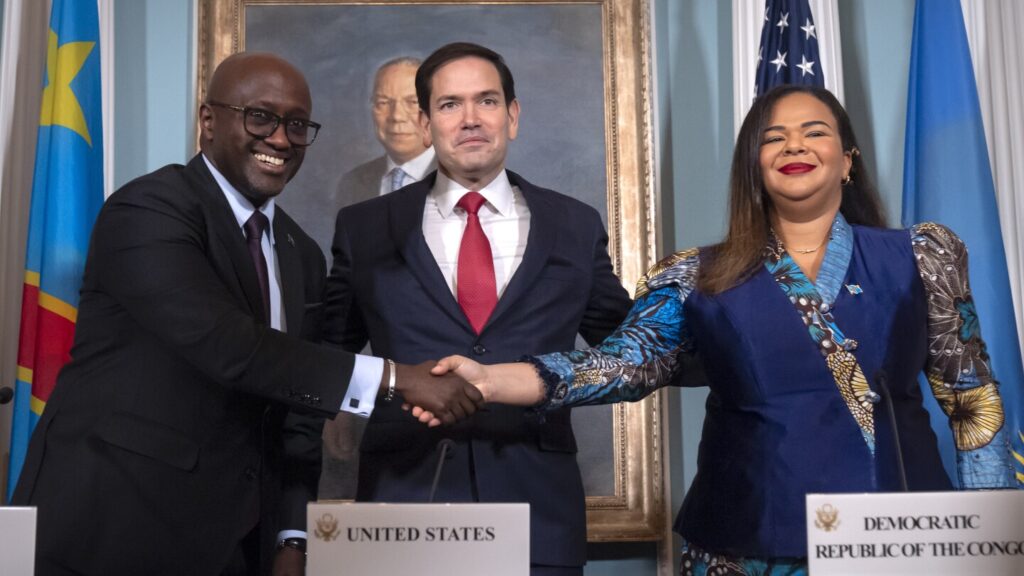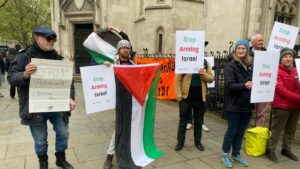
WASHINGTON — In a landmark development, the Democratic Republic of Congo and Rwanda have signed a U.S.-mediated peace deal aimed at ending decades of deadly conflict in eastern Congo. This agreement, signed on Friday, also opens avenues for the U.S. and American companies to access critical minerals in the region.
Breaking: Historic Peace Agreement Reached
“Today, the violence and destruction comes to an end, and the entire region begins a new chapter of hope and opportunity, harmony, prosperity and peace,” President Donald Trump declared to the foreign ministers of both nations during a meeting at the White House.
The agreement was formalized earlier at the State Department’s Treaty Room, under the watchful gaze of a portrait of Colin Powell, the first African American Secretary of State. U.S. Secretary of State Marco Rubio hailed the deal as “an important moment after 30 years of war.”
Immediate Impact
The Central African nation of Congo has been embroiled in conflict involving over 100 armed groups, with significant backing from Rwanda, resulting in millions of deaths since the 1990s. While the deal is seen as a pivotal moment, analysts caution that it may not immediately halt the fighting, as the most prominent armed group claims it is not bound by the agreement.
Key Statistic: Over 6 million people have died due to the conflict in eastern Congo, according to humanitarian reports.
Key Details Emerge
Congo’s Foreign Minister Therese Kayikwamba Wagner and Rwandan Foreign Minister Olivier Nduhungirehe signed the agreement, expressing optimism tempered by the acknowledgment of significant work ahead.
“Some wounds will heal, but they will never fully disappear,” Wagner stated. “Those who have suffered the most are watching. They are expecting this agreement to be respected, and we cannot fail them.”
Nduhungirehe highlighted the “great deal of uncertainty” due to previous agreements failing to materialize. He noted, “There is no doubt that the road ahead will not be easy. But with the continued support of the United States and other partners, we believe that a turning point has been reached.”
By the Numbers
Conflict Impact: Over 7 million people displaced in Congo, according to the United Nations.
The agreement includes provisions on territorial integrity, prohibition of hostilities, and the disengagement, disarmament, and conditional integration of non-state armed groups.
Industry Response
The peace deal aligns with the U.S. strategy to secure critical minerals at a time when the U.S. and China are vying for influence in Africa. Congo hopes the U.S. will provide security support to combat rebels and potentially facilitate their withdrawal from key cities like Goma and Bukavu.
Economic Value: Untapped minerals in Congo are estimated to be worth up to $24 trillion, according to the U.S. Department of Commerce.
What Comes Next
While the peace deal is a significant step, the Rwanda-backed M23 rebel group, a major player in the conflict, has indicated that the agreement may not be binding for them. The group has not been directly involved in the peace talks, although separate discussions are ongoing in Qatar.
Christian Moleka, a political scientist at the Congolese think tank Dypol, described the deal as a “major turning point” but warned it could not resolve all conflict issues. “The current draft agreement ignores war crimes and justice for victims by imposing a partnership between the victim and the aggressor,” he said.
Background Context
The conflict traces back to the aftermath of the 1994 genocide in Rwanda, where Hutu militias killed between 500,000 and 1 million ethnic Tutsi, along with moderate Hutus and Twa, Indigenous people. When Tutsi-led forces retaliated, nearly 2 million Hutus fled to Congo, fearing reprisals.
Rwandan authorities have accused the Hutus who fled of participating in the genocide and allege that elements of the Congolese army protected them. The militias formed by a fraction of the Hutus are viewed as a threat to Rwanda’s Tutsi population.
Expert Analysis
Analysts suggest the U.S. commitment to the peace process may hinge on access to minerals under separate negotiations between American and Congolese governments. The deal is part of a broader U.S. strategy to counter China’s influence in Africa, where Chinese companies have been dominant in Congo’s mineral sector.
Regional Implications
The peace agreement has been supported by the Gulf Arab nation of Qatar, which has been involved in facilitating discussions at the behest of the U.S. and other stakeholders. However, the path to peace remains fraught with challenges, as past agreements have failed to bring lasting stability.
As the region looks forward, the international community remains watchful of the implementation of this historic agreement and its potential to bring enduring peace to a region long plagued by conflict.
— Asadu reported from Dakar, Senegal. AP writers Edith M. Lederer at the United Nations, Justin Kabumba in Goma, Congo, and Ignatius Ssuuna in Kigali, Rwanda, contributed to this report.






